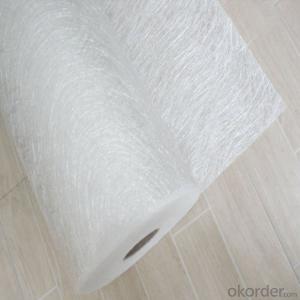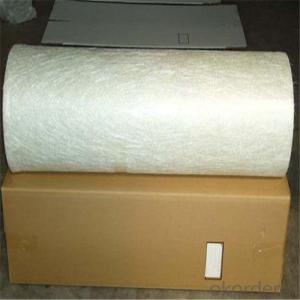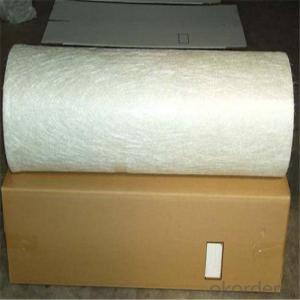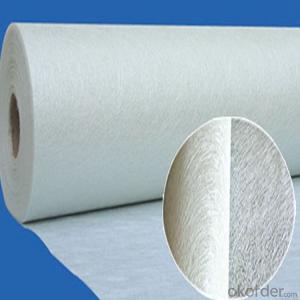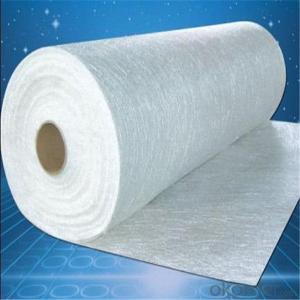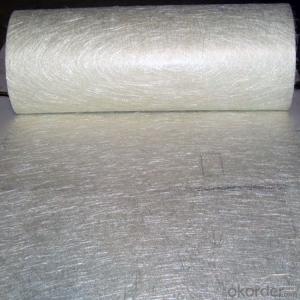Fiberglass Strands Chopped 450gsm Powder Fiberglass Chopped Strand Mat C Glass
- Loading Port:
- China main port
- Payment Terms:
- TT OR LC
- Min Order Qty:
- 1 kg
- Supply Capability:
- 5000 kg/month
OKorder Service Pledge
OKorder Financial Service
You Might Also Like

Product Description:
Chopped strand mat is made from chopped glass fibers, which are bonded with powder or emulsion binders. It can be used in hand lay-up process and continuous laminating process to produce FRP products, such as plates, lighting board, hull, bathtub, cooling towers, anti-corrosion materials, vehicles.
Features:
Uniform thickness, softness and hardness good.
Good compatibility with resin, easy completely wet-out.
Fast and consistent wet-out speed in resins and good manufacturability.
Good mechanical properties, easy cutting.
Good cover mold, suitable for modeling complex shapes.
Application:
fiberglass thickness is suitable for application by hand lay-up, reinforce and machine FRP molding,
including interior decoration of vehicles, boat hulls, complete set of sanitary equipment, anticorrosive pipes, tanks, building materials, tables, chairs, panels and all kind of composite FRP products.
Specifications:
Item | Over Density | Moisture Content | Chop Density | Polyester Yarn | Width |
(g/m2) | (%) | (g/m2) | (g/m2) | (mm) | |
EMK300 | 309.5 | ≤0.15 | 300 | 9.5 | 50-3300 |
EMK380 | 399 | 380 | 19 | ||
EMK450 | 459.5 | 450 | 9.5 | ||
EMK450 | 469 | 450 | 19 | ||
EMC0020 | 620.9 | 601.9 | 19 | ||
EMC0030 | 909.5 | 900 | 9.5 |
Special products are available according to customer’s requirement.
Product Packaging:
Each Surface Tissue is wound onto a paper tube which has an inside diameter of 76mm and the mat roll has a diameter of 330mm. The mat roll is wrapped up with plastic film,and then packed in a cardboard box or wrapped up with kraft paper. The rolls can be vertically or horizontally placed. For transportation, the rolls can be loaded into a cantainer directly or on pallets.
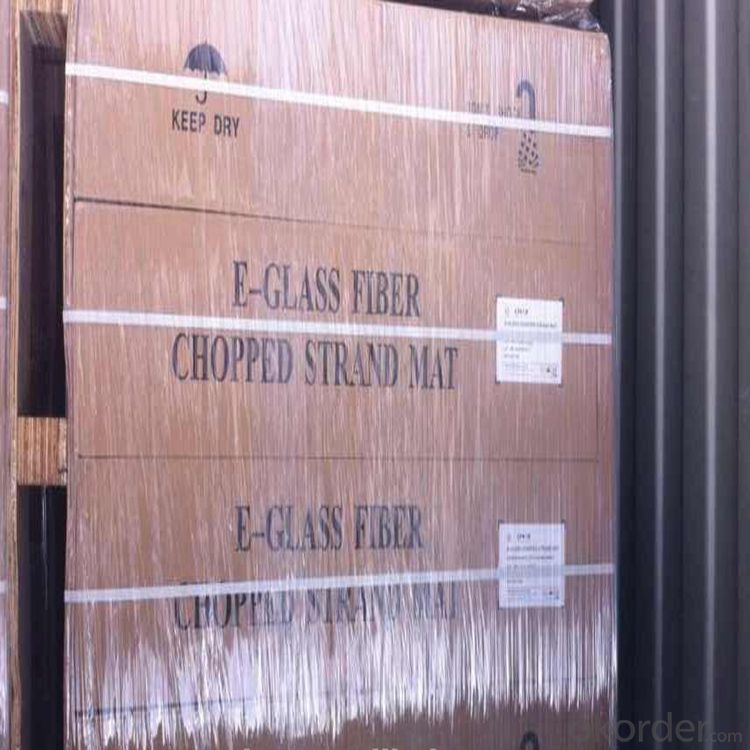
Product Storage:
Unless otherwise specified, Chopped Strand Mat should be stored in a dry, cool and rain-proof area. It is recommended that the room temperature and humidity should be always maintained at 15℃~35℃ and 50%~75% respectively.
Company Information
CNBM (China National Building Material) Group is the largest comprehensive building materials group in China that in integrate scientific research, manufacturing and logistics into one entity. The largest building materials and equipment specialists in China. Upon State Council approval, today CNBM owned more than 300 subordinate manufacturing factories and servicing companies. There are 6 fully owned public listed companies and 11 partially owned with substantial shares public listed companies. In many of these fields, CNBM is playing the leading role in the building industry in the country.

Order Information
Ordering please specify:
1. the product code, 2. weight, 3. width, 4. order quantity, 5. packaging, 6. special requirements please specify.
FAQ:
1. How long will you get reply?
Any inquiry will be replied within 24 hours. Usually we will reply within 12 hours.
2. How long is warranty period?
We provide 3 year warranty period.
3. What is your MOQ?
Any order quantity is available.
4. Can you provide sample?
Yes, samples are in stock. we can offer free sample for you.
5. Payment terms?
We can accept L/C, T/T, Western Union, Paypal etc.
6. Do you offer OEM service?
Yes, we can print customers’ logo on the packaging;
And the size and specification can be produced and design according to your demand.
7. What is the Production Lead Time?
15-20 days for bulk production after confirm the order.
- Q: Can fiberglass chopped strand be used in marine applications?
- Yes, fiberglass chopped strand can be used in marine applications. It is commonly used in boatbuilding and other marine structures due to its excellent strength, durability, and resistance to water and corrosion.
- Q: How does the diameter-to-length ratio of fiberglass chopped strand affect its performance?
- The performance of fiberglass chopped strand is greatly influenced by its diameter-to-length ratio. The strength and stiffness of the material are affected by the diameter of the strands, while the length determines its ability to disperse and reinforce the matrix. Better mechanical properties are typically achieved with a higher diameter-to-length ratio. This is because a larger diameter increases the surface area and improves the bonding between the strands and the matrix. As a result, stress can be transferred more efficiently, enhancing the overall strength and load-bearing capacity of the composite. Furthermore, a higher diameter-to-length ratio allows for improved dispersion of the chopped strands within the matrix. Longer strands tend to clump together, making it challenging to achieve a uniform distribution in the composite. However, with a higher diameter, the strands can separate more easily, leading to better reinforcement throughout the material. Nevertheless, it is important to consider the specific application and desired performance characteristics when determining the optimal diameter-to-length ratio. In certain cases, shorter strands with a lower diameter-to-length ratio may be preferred, especially in applications where impact resistance or a smoother surface finish is crucial. To summarize, the performance of fiberglass chopped strand is significantly influenced by its diameter-to-length ratio. A higher ratio generally results in improved mechanical properties and better dispersion, enhancing the overall strength and reinforcement capabilities of the composite. However, the ideal ratio may vary depending on the specific application requirements.
- Q: Uses, specifications and functions of the Geogrid.
- Geogrid is a major geosynthetics. Compared with other geosynthetics, it has a unique performance and effectiveness. Geogrid is usually used as the reinforced soil structure tendon material or composite material geosynthetics. The geogrid is divided into plastic geogrid, steel plastic geogrid, glass fiber geogrid and fiberglass polyester geogrid. (1) The plastic geogrid is Polymer netting materials with a square or rectangular shape after pultrusion. According to the direction of pultrusion, it can be divided into uniaxial?tension and two-way stretch. It is punched in the polymer sheet material (raw material is polypropylene or high density polyethylene) after pultrusion, and then operate orientation stretching in heating codition. The aniaxial tension geogrids is made only along the length direction of the sheet, while the two-way stretching gridgeogrids is made by pultrusion the aniaxial tension geogrids along the direction which is vertical to the length.
- Q: Two-way stretch plastic geogrid
- High-intensity Geonet, Geotextile, Uniaxial Plastic Geogrid, Steel-plastic composite Geogrid, Composite geomembrane, and two double to the grid line, Maree Modoo axial loom, Fiberglass geogrid, Polyester geogrid, Geonet, two one-way grille production line, Dornier loom.
- Q: Does fiberglass chopped strand improve the fire resistance of composite materials?
- Yes, fiberglass chopped strand can improve the fire resistance of composite materials. Fiberglass is known for its high melting point and low thermal conductivity, making it a suitable reinforcement material for enhancing fire resistance properties in composites. When added to a composite material, fiberglass chopped strand can act as a barrier, preventing the spread of flames and reducing the rate of heat transfer. Additionally, the use of fiberglass chopped strand can enhance the structural integrity of the composite during fire exposure, as it has a high strength-to-weight ratio. However, it is important to note that the fire resistance properties of a composite material also depend on other factors such as the resin matrix used, the manufacturing process, and the overall composition of the composite.
- Q: Is fiberglass chopped strand suitable for applications requiring high electrical insulation?
- No, fiberglass chopped strand is not suitable for applications requiring high electrical insulation. While fiberglass is a strong and versatile material, it is not known for its electrical insulation properties. Fiberglass chopped strand is typically used in applications where strength, resistance to corrosion, and thermal insulation are required, such as in automotive parts, boats, and construction materials. For applications requiring high electrical insulation, other materials like silicone rubber, polyethylene, or polypropylene would be more suitable choices. These materials have better dielectric properties and are specifically designed to provide excellent electrical insulation.
- Q: How does the surface treatment of the chopped strand affect its performance?
- The surface treatment of the chopped strand can significantly affect its performance. The treatment helps improve the adhesion between the strand and the resin matrix, resulting in enhanced mechanical properties and overall strength of the composite material. It also helps reduce fiber breakage during processing and improves the strand's wet-out characteristics, leading to better fiber dispersion and resin impregnation. Additionally, the surface treatment can enhance the strand's resistance to moisture, chemicals, and environmental degradation, thereby improving its durability and long-term performance.
- Q: Can fiberglass chopped strand be used in electrical motors?
- Yes, fiberglass chopped strand can be used in electrical motors. Fiberglass is an excellent insulating material and is commonly used in electrical applications due to its high electrical resistance and thermal stability. Chopped strand can be used as a reinforcement in the insulation system of electrical motors, providing mechanical strength and enhancing the overall performance of the motor. Additionally, fiberglass is lightweight and has good dimensional stability, making it a suitable choice for electrical motors that require high efficiency and reliability.
- Q: What is the cost of fiberglass chopped strand compared to other materials?
- The price of fiberglass chopped strand can vary based on factors such as quality, quantity, and supplier. However, generally speaking, fiberglass chopped strand is considered a cost-effective material compared to other options. When compared to materials like carbon fiber or aramid, fiberglass chopped strand is typically more affordable. This is because the production process of fiberglass is simpler and less expensive. Additionally, fiberglass chopped strand is readily available and has a significant market share, which helps keep prices competitive. In contrast to traditional materials like steel or aluminum, fiberglass chopped strand can also provide cost advantages. Fiberglass is generally lighter in weight, which can lower transportation and installation costs. It is also resistant to corrosion, eliminating the need for additional coatings or treatments to prevent rust or deterioration. Moreover, fiberglass chopped strand offers excellent strength-to-weight ratios, making it a cost-effective option for applications requiring high strength and durability. It is important to note that while fiberglass chopped strand may have a lower initial cost compared to some materials, the overall cost-effectiveness depends on the specific application, performance requirements, and long-term maintenance considerations. Conducting a comprehensive cost analysis and considering factors beyond the initial purchase price is crucial in determining the true cost of using fiberglass chopped strand compared to other materials.
- Q: Can fiberglass chopped strand be used in the production of boat hulls?
- Fiberglass chopped strand is indeed applicable for boat hull production. This reinforcement material, widely utilized in composite materials like boat hulls, is made up of randomly chopped glass fibers that are combined with resin to form a robust and durable composite material. Incorporating fiberglass chopped strand into the production of boat hulls enhances their strength, rigidity, and resistance to impacts, thus enabling them to endure the harsh marine conditions. Moreover, this material can be easily shaped into intricate forms, enabling boat manufacturers to create hulls with specific designs and features. All in all, fiberglass chopped strand is a popular and efficient material employed in boat hull manufacturing.
Send your message to us
Fiberglass Strands Chopped 450gsm Powder Fiberglass Chopped Strand Mat C Glass
- Loading Port:
- China main port
- Payment Terms:
- TT OR LC
- Min Order Qty:
- 1 kg
- Supply Capability:
- 5000 kg/month
OKorder Service Pledge
OKorder Financial Service
Similar products
Hot products
Hot Searches
Related keywords
